 |
 |
 |
 |
 |
 |
| |
 |
|
 |
 |
 |
  |
  |
 |
 |
 |
 |
|
|
 |
|
 |
 |
 |
BUILDING |
 |
|
 |
|
 |
 |
 |
| |
 |
| 
 |
Museum of Islamic Art - MIA
|
|
 |
 |
 |
 |
DESIGNER |
 |
|
|
 |
|
 |
 |
 |
| |
 |
|
 |
 |
 |
 |
DESCRIPTION |
 |
|
|
 |
|
 |
 |
 |
|
|
 |
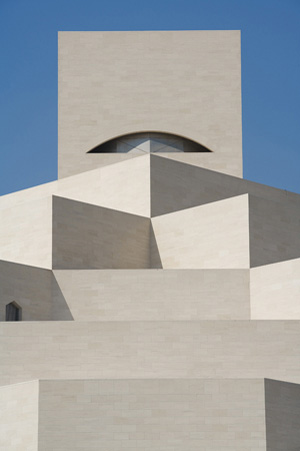 The Museum of Islamic Art is the result of a journey of discovery conducted by I.M. Pei, whose quest to understand the diversity of Islamic architecture led him on a world tour. During visits to the Grand Mosque in Córdoba, Spain; Fatehpur Sikri, a Mughal capital in India; the Umayyad Great Mosque in Damascus, Syria; and the ribat fortresses at Monastir and Sousse in Tunisia, he found that influences of climate and culture led to many interpretations of Islamic architecture, but none evoked the true essence he sought. The Museum of Islamic Art is the result of a journey of discovery conducted by I.M. Pei, whose quest to understand the diversity of Islamic architecture led him on a world tour. During visits to the Grand Mosque in Córdoba, Spain; Fatehpur Sikri, a Mughal capital in India; the Umayyad Great Mosque in Damascus, Syria; and the ribat fortresses at Monastir and Sousse in Tunisia, he found that influences of climate and culture led to many interpretations of Islamic architecture, but none evoked the true essence he sought.
Mr. Pei’s final design inspiration was the 13th-century sabil (ablutions fountain) of the Mosque of Ahmad Ibn Tulun in Cairo, Egypt (9th century). In the “austerity and simplicity” of the sabil, Mr. Pei stated, he found “a severe architecture that comes to life in the sun, with its shadows and shades of colour.” The sabil offered “an almost Cubist expression of geometric progression,” which evoked an abstract vision of the key design elements of Islamic architecture.
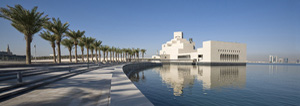 Declining to build the structure on any of the proposed sites along the Corniche, Mr. Pei suggested a stand-alone island be created to ensure future buildings would never encroach on the Museum. The building stands in the sea some 195 feet off Doha’s Corniche. A park of approximately 64 acres of dunes and oases on the shoreline behind the Museum offers shelter and a picturesque backdrop. Declining to build the structure on any of the proposed sites along the Corniche, Mr. Pei suggested a stand-alone island be created to ensure future buildings would never encroach on the Museum. The building stands in the sea some 195 feet off Doha’s Corniche. A park of approximately 64 acres of dunes and oases on the shoreline behind the Museum offers shelter and a picturesque backdrop.
Built of fine materials, such as cream-coloured Magny and Chamesson limestone from France, Jet Mist granite from the United States and stainless steel from Germany, as well as architectural concrete from Qatar, the Museum is composed of a five-storey main building and a two-storey Education Wing, which are connected across a central courtyard. The main building’s angular volumes step back progressively as they rise around a 164-foot-high domed atrium, which is concealed from outside view by the walls of a central tower. At the top of the atrium, an oculus captures and reflects patterned light within the faceted dome. The desert sun plays a fundamental role, transforming the architecture into a play of light and shadows.
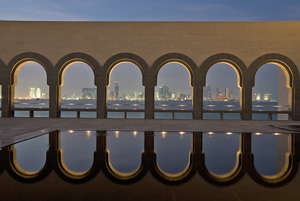 A glass curtain wall on the north side of the Museum offers panoramic views of the Gulf and West Bay area of Doha from all five floors of the atrium. Ceilings are embellished with intricate coffered domes, and perforated metal chandeliers hang in the atrium. Two more lanterns, each 100 feet tall, mark the boat dock on the west side of the Museum, creating a grand entrance for guests arriving by boat. A glass curtain wall on the north side of the Museum offers panoramic views of the Gulf and West Bay area of Doha from all five floors of the atrium. Ceilings are embellished with intricate coffered domes, and perforated metal chandeliers hang in the atrium. Two more lanterns, each 100 feet tall, mark the boat dock on the west side of the Museum, creating a grand entrance for guests arriving by boat.
The galleries, designed by Jean-Michel Wilmotte from Paris, France feature dark grey porphyry stone and Louro Faya, a Brazilian lacewood that was brushed and treated to create a metallic appearance, which contrast with the light-coloured stonework of the rest of the Museum. To protect the fragile antiquities on display, the exhibition rooms feature specially designed cases and lighting. Mr. Wilmotte also created custom furniture for the museum, inspired by Pei’s architectural style.
The Museum’s education programs are housed in a 29,000-square-foot wing, located to the east of the main building across a fountain courtyard. The Education Wing, scheduled to open late 2009, includes a light-filled reading room in the Museum library, classrooms, workshops, study spaces, and technical and storage facilities. Among the latter is the conservation laboratory, an important new resource for the entire region. Underscoring the central role of education in the Museum of Islamic Art, the Education Wing will host educational and community activities to develop and foster an understanding and appreciation for Islamic art. |
|
 |
 |
 |
|
 |
|
| An interview with I.M. Pei by Philip Jodidio |
 |
|
 |
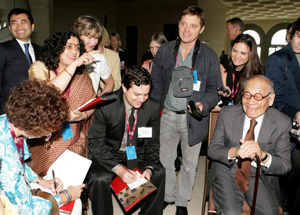 How did you come to be involved in the design and construction of the new Museum of Islamic Art in Doha? How did you come to be involved in the design and construction of the new Museum of Islamic Art in Doha?
I believe that the Aga Khan organized a competition in 1997 from which two architects emerged. The first choice of the jury was Charles Correa and the second choice was a Lebanese architect called Rasem Badran. Badran was selected by the State of Qatar to build the museum on the Corniche. His project unfortunately did not go forward, and I was contacted by Luis Monreal, who had been a member of the original jury. Mr. Monreal, now General Manager of the Aga Khan Trust for Culture, knew that I did not participate in competitions, but he persuaded the Emir that I might be a good choice to design the new museum. I was offered a number of sites along the Corniche including the originally planned location, but I did not accept these options. There were not yet too many buildings nearby, but I feared that in the future, large structures might rise that would overshadow it. I asked if it might not be possible to create my own site. This was very selfish of me of course, but I knew that in Qatar it is not too complicated to create landfill.
The Museum of Islamic Art is located on the south side of Doha’s Corniche on a man-made island sixty metres from the shore. A new C-shaped peninsula provides protection from the Arabian Gulf on the north and from unsightly industrial buildings on the east.
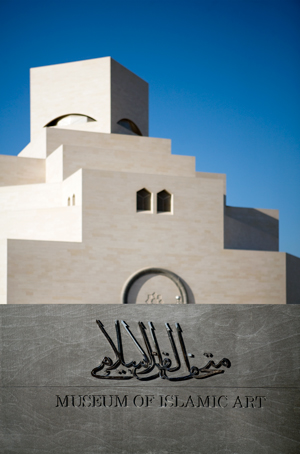 Once you were asked to work in Doha, what was the process that led to your final design? Once you were asked to work in Doha, what was the process that led to your final design?
This was one of the most difficult jobs I ever undertook. It seemed to me that I had to grasp the essence of Islamic architecture. The difficulty of my task was that Islamic culture is so diverse, ranging from Iberia to Mughal India, to the gates of China and beyond. I was familiar with the Grand Mosque in Córdoba (784-66, 961-66, 987-90) and I thought that it represented the pinnacle of Islamic architecture, but I was wrong. The combined influence of climate and the culture of Spain meant that Córdoba was not the pure expression I was seeking. The same was true, for different reasons, of Fatehpur Sikri, a Mughal capital where one of the largest mosques in India, the Jama Masjid, was built. I recognize that my intellectual process might be considered very subjective, but here the Indian influence is tangible, and again I had not found my inspiration. Even the Umayyad Great Mosque in Damascus (709-15), the oldest extant monumental mosque, seems to carry with it elements of the history of Rome or of early Christianity. A Roman temple and a Byzantine church had stood on this site before the mosque was built. Where Byzantine influence could be felt, I again decided that my quest had not reached its goal. I went to Tunisia and although my intention had been to examine the mosques, I was taken with another type of architecture in the form of the ribat fortresses at Monastir (796) and Sousse (821). There, I felt I was coming closer to the essence of Islamic architecture, where sun brings to life powerful volumes and geometry plays a central role.
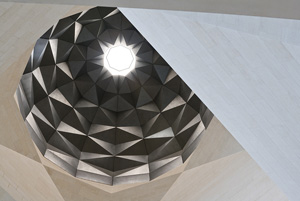 Where did you finally find the building that you came to consider as the essence of Islamic architecture? Where did you finally find the building that you came to consider as the essence of Islamic architecture?
I began to understand why I felt that Córdoba was not truly representative of the essence I was seeking. It is too lush and colorful. If one could find the heart of Islamic architecture, might it not lie in the desert, severe and simple in its design, where sunlight brings forms to life? I was finally coming closer to the truth, and I believe I found what I was looking for in the Mosque of Ahmad Ibn Tulun in Cairo (876-879). The small ablutions fountain surrounded by double arcades on three sides, a slightly later addition to the architecture, is an almost Cubist expression of geometric progression from the octagon to the square and the square to the circle. It is no accident that Le Corbusier learned much from the architecture of the Mediterranean and the architecture of Islam. This severe architecture comes to life in the sun, with its shadows and shades of color. In the middle of the mosque of Ibn Tulun, I had at last found what I came to consider to be the very essence of Islamic architecture in the middle of the mosque of Ibn Tulun.
Your design surely evokes an abstract vision of the purity of Ibn Tulun, but you have also introduced a number of decorative elements into the design, have you not?
I remained faithful to the inspiration I had found in the Mosque of Ibn Tulun, derived from its austerity and simplicity. It was this essence that I attempted to bring forth in the desert sun of Doha. It is the light of the desert that transforms the architecture into a play on light and shadow. My design has only one major window – it is 45 metres high and faces the Persian Gulf. I must admit that I have allowed myself another subjective decision, which was based on my feeling that Islamic architecture often comes to life in an explosion of decorative elements, in the courtyard of the Umayyad Mosque in Damascus, or the interior of the Dome of the Rock in Jerusalem (687- 691) for example. I have also particularly admired the perforated metalwork in Egypt. Thirty-two-metre high, perforated lanterns will hang in the new museum, visible from great distances across the water, along the Corniche. The central space climaxes in the oculus of a stainless steel dome that captures patterned light in its multiple facets. A geometric matrix transforms the dome’s descent from circle to octagon, to square, and finally to four triangular flaps, which angle back at different heights to become the atrium’s column supports. |
|
 |
 |
 |
 |
 |
 |
 |
MATERIALS |
 |
|
|
 |
|
 |
 |
 |
 |
 |
|
stone, granite, steel, reinforced concrete Cream-coloured Magny and Chamesson limestone from France
Dark grey porphyry stone and Louro Faya from France
Jet Mist granite from the United States
Stainless steel from Germany
Concrete from Qatar
Lacewood from Brazil
|
|
 |
 |
 |
 |
LOCATION |
 |
|
|
 |
|
 |
 |
 |

|
 |

|
Continent |
|
 |
  Asia |
|
Nation |
|
 |
  Qatar [Dawlat al-Qatar] |
|
Municipality |
|
 |
  Ad Dawhah |
|
Town |
|
 |
  Doha |
|
Address |
|
 |
  Al Corniche Street (Grand Hamad Street)
|
|
|
|
 |
|
Telephone |
|
 |
|
Website |
|
 |
|
E-mail |
|
 |
|
 |
 |
 |
 |
MAP |
 |
|
|
 |
|
 |
 |
 |
| |
 |
|
 |
 |
 |
 |
|
TYPOLOGY |
 |
|
|
 |
|
 |
 |
 |
Main |
 |
|
 |
ARCHITECTURE | Buildings for cultural activities
Art galleries and exhibition areas
Museums and buildings for exhibitions
Art museums
Ethnographic museums
| |
|
|
 |
|
Additional |
 |
|
 |
ARCHITECTURE | Education buildings
Other education centres
Commercial buildings
Bars, cafeterias
Religious buildings
Churches and places of worship
Buildings for recreational activities
Auditoriums and music centres
Urban equipment and structures for public areas
Structures for public areas
| |
 |
 |
 |
 |
CHRONOLOGY |
 |
|
|
 |
|
 |
 |
 |
Realisation |
 |
|
 |
| 
 |
2008 |
|
 |
 |
 |
 |
AWARDS |
 |
|
|
 |
|
 |
 |
 |
| 2008 |
 |
|
 |
Platinum Award for Engineering Excellence
ACEC New York |
|
 |
 |
 |
|
 |
|
| 2007 |
 |
|
 |
Award of Merit (Out of Country)
Concrete Industry Board |
|
 |
 |
 |
 |
 |
 |
 |
BIBILIOGRAPHIC REFERENCES |
 |
|
|
 |
|
 |
 |
 |
|
 |
| Paula Deitz, "Museum of Islamic Art, Doha. I.M. Pei", Architectural Record 8/2009, august 2009, pp. 60-65 |
|
|
| William Wiles, "I.M. Pei has completed his last major commission, the Museum of Islamic Art in Doha, Qatar", Icon 68, february 2009, p. 39 |
|
|
 Philip Jodidio, Sabiha Al Khemir, Museum of Islamic Art. Doha. Qatar, Prestel, USA 2009 Philip Jodidio, Sabiha Al Khemir, Museum of Islamic Art. Doha. Qatar, Prestel, USA 2009 |
|
|
| François Chaslin, "Geometrias remotas. I. M. Pei inaugura el Museo de Arte Islamico en Doha/Remote geometries. I. M. Pei designs the Museum of Islamic Art in Doha", Arquitectura Viva 122, IX-X 2008 [La casa asequible], "Arte / Cultura, Argumentos y reseñas", pp. 70-71 |
|
|
| Luis Fernández-Galiano, "Lugares sagrados / Sacred Places", Arquitectura Viva 122, IX-X 2008 [La casa asequible], "Arte/Cultura" pp. 68-69 |
|
 |
 |
 |
 |
 |
 |
 |
CLIENT |
 |
|
|
 |
|
 |
 |
 |
| |
 |
Qatar Museum Authority (QMA)
Sheikh Hamad bin Khalifa Al Thani (Emir of Qatar) |
|
 |
 |
 |
 |
DIMENSIONAL
DATA |
 |
|
|
 |
|
 |
 |
 |
| Surface |
 |
|
 |
site ha. 20
sq.m. 35,500 (sq.ft. 340,000) |
|
| Floors |
 |
|
 |
|
| Capacity |
 |
|
 |
|
 |
 |
 |
 |
STRUCTURES |
 |
|
|
 |
|
 |
 |
 |
| |
 |
| Leslie E. Robertson Associates |
|
 |
 |
 |
 |
STAFF |
 |
|
|
 |
|
 |
 |
 |
Project  |
 |
| I.M. Pei Architect, New York |
|
|
 |
|
|
 |
|
Interior design |
 |
|
Associate architect |
 |
| Qatar Engineer & Associates |
|
Architect of record |
 |
| I.M. Pei Architect: TohTsun Lim |
|
Project management |
 |
I.M. Pei Architect: Perry Y. Chin
Interiors/Jean-Michel Wilmotte: Emmanuel Brelot |
|
Design architects |
 |
I.M. Pei Architect: Hiroshi Okamoto
Interiors/Jean-Michel Wilmotte: Xavier Turk |
|
Principal-in-charge |
 |
| I.M. Pei Architect: Fatma Aslihan Demirtas |
|
Project architect |
 |
I.M. Pei Architect: Deborah Ann Campbell
Interiors/Jean-Michel Wilmotte: Fabian Servagnat |
|
Design team |
 |
I.M. Pei Architect: Haruko Fukui, Rayme Kuniyuki, Stephen A. Hopkins, Aki Ishida, Chris Rand, Yi Chi Su, Andy Mei
Interiors/Jean-Michel Wilmotte: Barbara Clout, Abir Fawaz, Hoon Moreau, Emilie Oliverio, Jean-Luc Perrin, Michael Placidi, Moochul Shin |
|
Consultant |
 |
| I.M. Pei Architect: Michael Visscihelli |
|
Mechanical engineer |
 |
|
Lighting engineer |
 |
|
Acoustical consultant |
 |
|
Audiovisual design |
 |
|
Water engineering |
 |
|
General contractor |
 |
|
 |
 |
 |
 |
CREDITS |
 |
|
|
 |
|
 |
 |
 |
| |
 |
Photos © Museum of Islamic Art - MIA
Text edited by Museum of Islamic Art - MIA
Courtesy by Museum of Islamic Art - MIA
|
|
 |
  |
 |
|
|